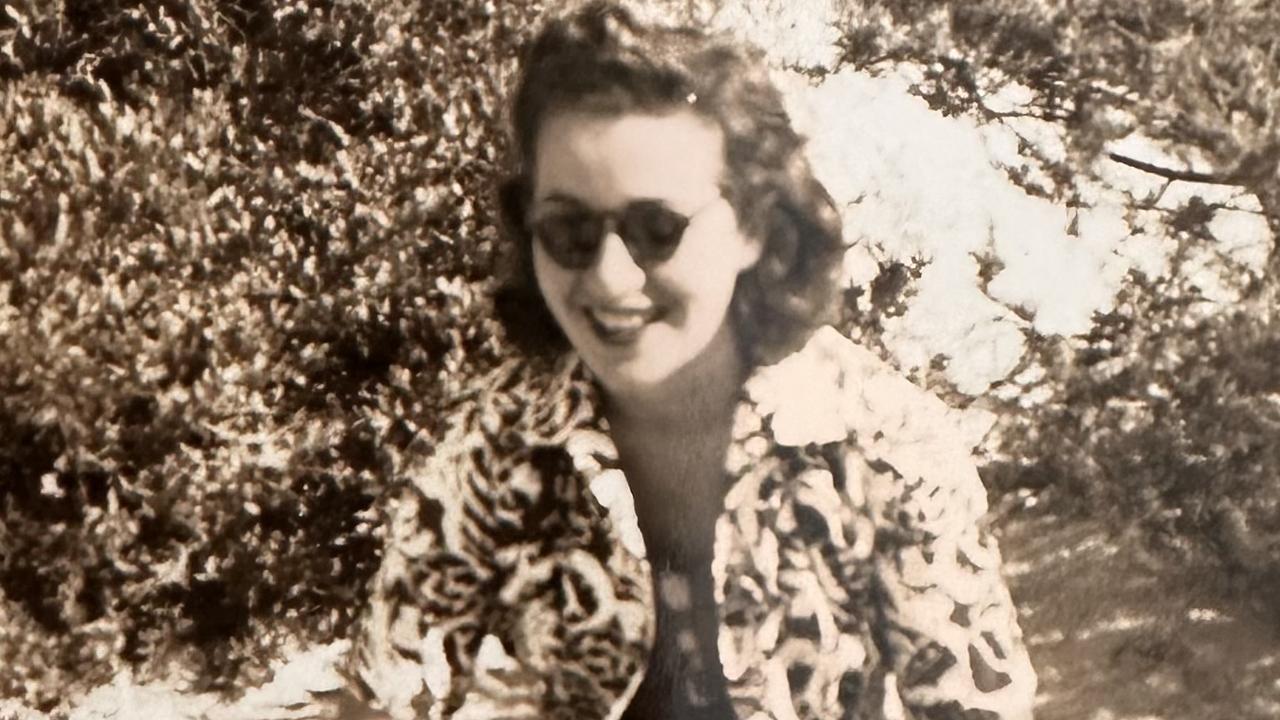Today in history: Hungry dogs put Russian scientist Ivan Pavlov on track for Nobel Prize
When Ivan Pavlov noticed dogs in his laboratory drooled at the expectation of food, it inspired a revolutionary series of experiments which had many implications for modern science
Today in History
Don't miss out on the headlines from Today in History. Followed categories will be added to My News.
- The new political series everyone will be talking about
- Swingers, sex and death: Sydney mystery inspires new drama
*****
1849: BIRTH OF RUSSIAN PHYSIOLOGIST IVAN PAVLOV
Russian physiologist Ivan Pavlov was studying the role of salivation in the process of digestion. In his experiments he used dogs, collecting their saliva to see precisely how much they salivated when given food.
But he began to observe something else of interest. The dogs he had used in repeated tests tended to salivate before they came into contact with the food. Some would even salivate without actually seeing the food, or smelling it. The sight or sound of a lab assistant who brought the food was enough to stimulate them.
This set Pavlov off on a new line of research, to find out how much conditioning it would take to stimulate the salivation reflex. It led to the famous series of experiments using dogs responding not just to bells (as many people believe) but also to a metronome, lights, whistles, buzzers and other stimuli. He called it “conditional response” but when it was translated from the Russian it became known in English as “conditioned response” also known as the “Pavlovian response”.
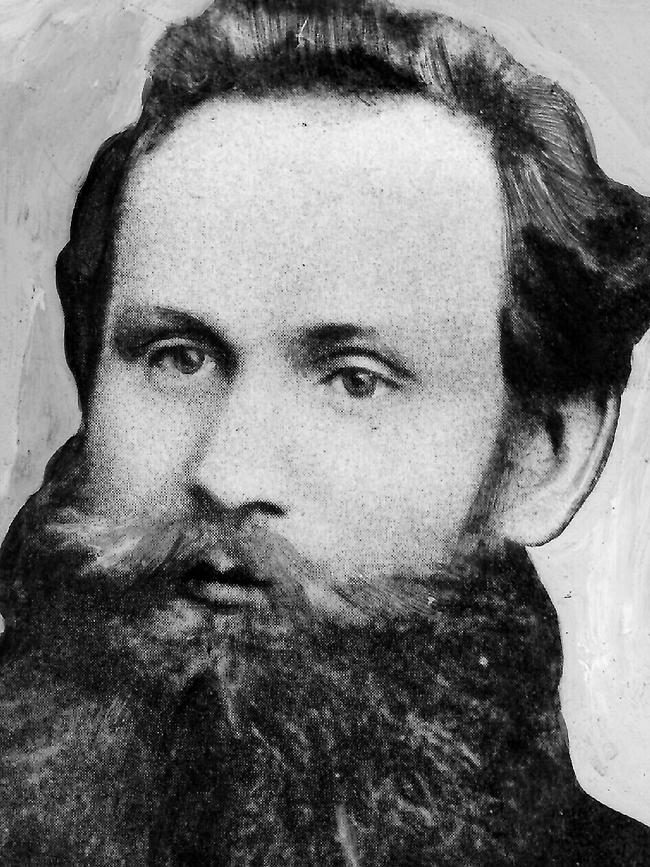
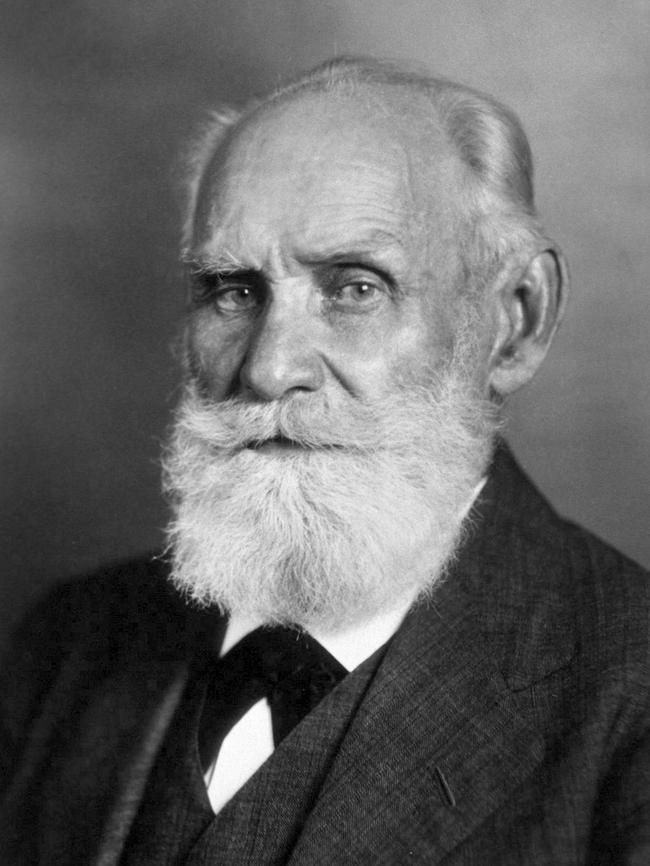
For his work in the field Pavlov was awarded the 1904 Nobel Prize in physiology or medicine.
He was born on September 26 (September 14 before the change in the calendar) 1849, in Rayazan, Russia, the son of a village priest Educated at a church school and later sent to a seminary, after reading the work of Charles Darwin he decided that the priesthood was not for him. He left the seminary to study physics and mathematics at the University of St Petersburg. He later changed to study chemistry and physiology.
He gained his MD in 1879. Despite struggling financially he married Seraphima Vasilievna Karchevskaya in 1881, but the couple had to live separately in the first years of their marriage. Seraphima suffered a miscarriage with her first pregnancy. Their second child, a son named Wirchik, died suddenly in infancy, but they went on to have three sons and a daughter.
Pavlov earned his doctorate in 1883, with a dissertation on “The centrifugal nerves of the heart”, his work laying down some of the basic principles of the digestive functions of the nervous system. He then went to Germany to study under renowned cardiovascular physiologist Carl Ludwig.

Pavlov later returned to Russia where he became a skilled surgeon, able to perform delicate procedures but preferred research to practising medicine. In 1890 he was invited to organise and direct the Department of Physiology at the Institute of Experimental Medicine. It was during this period that he conducted his experiments with dogs. Some of these experiments would be deemed cruel by today’s standards, because they involved the surgical procedures such as the insertion of a tube into the dog’s mouth to collect the saliva and along with stimuli such as bells and metronomes he also administered mild shocks to see what effect it would have. But unlike other scientists who experimented on animals and then killed them, Pavlov preferred to keep his subjects alive.
He discovered dogs drooled when conditioned to a particular stimulus, but also found the conditioned responses could be eliminated by not reinforcing them for a time. It could reappear spontaneously or be easily reset with more reinforcement. This had many implications for science, including the emerging field of psychology.
He published his findings in 1903, and was soon nominated for a Nobel Prize. He had been nominated several times before but now there were more specific grounds for awarding him the prize. It was awarded to Pavlov in 1904 “in recognition of his work on the physiology of digestion, through which knowledge on vital aspects of the subject has been transformed and enlarged”.
Pavlov spent the rest of his years focusing on the field of conditioned reflexes, teaching generations of physiologists and inspiring new fields of psychology. But despite his standing as a great scientist, there were challenges.
When the communists came to power during the October Revolution in 1917, the disruption to private philanthropy through the state confiscating all wealth could have meant an end to his research. But communist leader Vladimir Lenin understood the importance of Pavlov’s work and issued a decree in 1921 saying “the outstanding scientific services of Academician I.P. Pavlov, which are of enormous significance to the working class of the whole world”.
The Soviet government guaranteed his funding and allowed him unlimited scope for research. But privately he was contemptuous of the communists, believing their experiment would soon falter. He died in 1936.
*****
1969: THE BRADY BUNCH PREMIERES
The opening titles for the new series began: “Here’s the story of a lovely lady, who was living with three very lovely girls …” It went on to tell how the lady met “a man named Brady” who had three boys of his own. The lovely lady married Mister Brady and “that’s the way they became the Brady Bunch”.
The show, which premiered 50 years ago today, was conceived by Sherwood Schwartz, the television executive who also gave us comedy Gilligan’s Island. The Brady Bunch was a half-hour sitcom, showing the weekly adventures of a blended family, living in a suburban home in Los Angeles, designed by the architect father Mike for his newly blended big family. Although not a huge hit during its original run on TV, it developed a loyal audience, doing battle with rival sitcom The Partridge Family. But in repeats, it became one of the best loved shows on TV. It spawned an animated series, a variety show starring most of the cast, reunion specials, a short-lived sequel and two films, with a different cast but cameos by some of the originals. The surviving cast recently reunited for A Very Brady Renovation, making over the house that was used for filming the exteriors to make it match the show.

It all began in the mid ’60s with Schwartz reading about the high percentage of American families in which there were children from a previous marriage. At the time he was still working on Gilligan’s Island but looking for ideas for a new sitcom.
He knew family series had once been popular but were beginning to look tired, yet if it had a gimmick like a blended family, it could be a hit.
He pitched to the network the idea for his show titled Yours And Mine, but they wanted to make a one-and-a-half-hour pilot. Schwartz told them no because it would be too dull. The show was rejected. A few years later when Lucille Ball and Henry Fonda had a hit with the 1968 film Yours, Mine And Ours about a blended family, the network decided to give Schwartz’s idea a second look.
Schwartz had to lose his original title Yours And Mine because it was too similar to the film so he had to settle for The Brady Bunch.
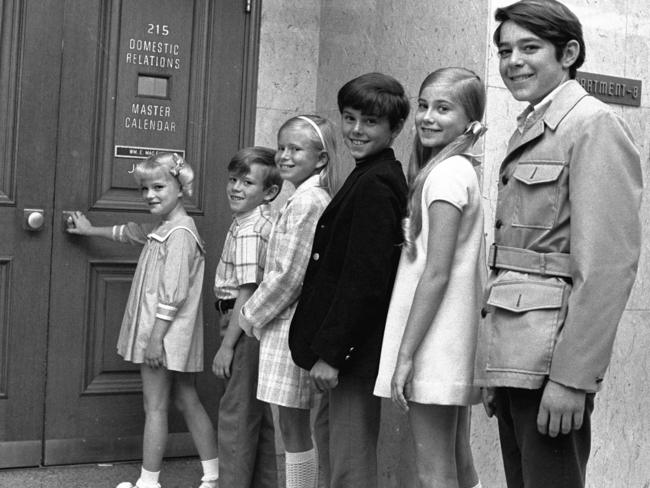
Producers began casting the children first, so they could match their hair colour and looks, with contrasting hair colours for the boys and the girls, then find a parent to match each.
After hundreds of auditions they narrowed it down to three blonde girls along with three brunettes, as well as three blond boys and three with dark hair. They went with the best actors. The problem was that golden haired Susan Olsen had won over Schwartz for the part of Cindy and the sandy haired Mike Lookinland was the best of the boys, trying out for Bobby. The solution was to dye his hair. Maureen McCormick and Eve Plumb were cast as Marcia and Jan, and Barry Williams and Christopher Knight, as Greg and middle brother Peter.
For the mother, Carol, producers wanted Joyce Bulifant, but after screen testing Florence Henderson they were convinced the part belonged to her. First choice for dad Mike was Gene Hackman, who was rejected because he wasn’t as well known as their second choice, classically trained actor Robert Reed.
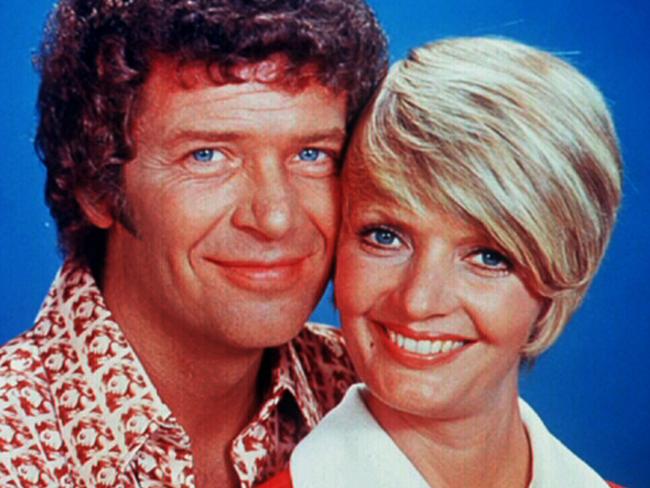
Reed initially didn’t want to do the show, but when two other offers came to nothing he reluctantly became the dad. His character was a widower and Carol was meant to be a divorcee, but network censors forbade any mention that she was divorced.
However, they were the first couple on American TV to be shown in the same bed, before, couples were seen in separate beds. The censors also wanted no toilet in the family bathroom. The show premiered on September 26, 1969. The first episode showed the wedding and how the children, complaining about favouritism by their step-parent, ending up going on the honeymoon. It was the only episode to specifically deal with the problems of blended families. While never No.1 in the ratings, it had a loyal audience who turned the young actors into pop stars when they released several records during the show’s run.
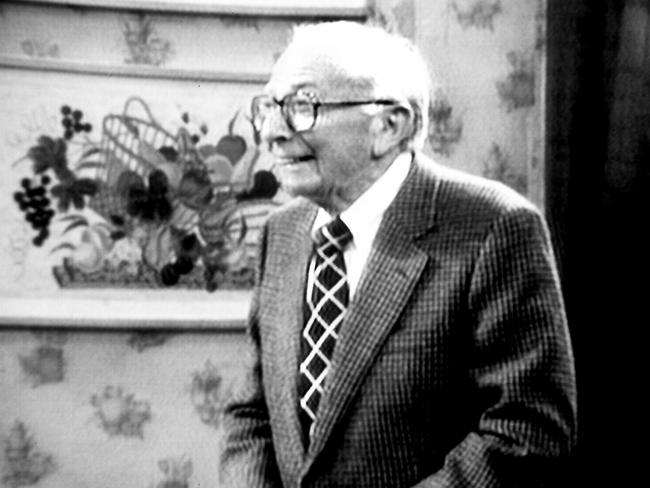
There were romances between each of the sets of siblings, but none ever became serious relationships. Williams raised some eyebrows when he said he went on a date with Henderson, but it turns out only to have been dinner and nothing else, although Williams admitted to having a huge crush on his screen mother.
When ratings began to wane a new character, Cousin Oliver (Robbie Rist), was introduced, but the show was cancelled in 1974.
A Very Brady Renovation airs on FOX8 from October 7 at 8.30pm
*****
SEPTEMBER 25, 1939: DRIFTER ALBERT ‘MAD’ MOSS SENTENCED TO HANG
The jury filed into the courtroom after two hours’ deliberation. Despite the fact that no complete bodies had been found, the jurors found sufficient evidence of a crime to find Albert Moss guilty on the charge of the murder of Timothy O’Shea.
Dubbed “Mad Moss”, this strange drifter was known for feigning madness to avoid conviction. But now, on September 25, 1939, 80 years ago today, his long criminal career was finally being brought to an end. After commending the police on bringing such a “daring criminal” to justice, the judge William Owens sentenced Moss to hang. His sentence would later be commuted to life in prison.
Although accused of the murder of two other men, Moss never went on trial for those murders, probably because since he was likely to die in prison, they believed the trials
would be a waste of time. But it may also have been because they were never really sure about his state of mind. As he was being led away from his trial he said to a police officer: “You and your mates think I murdered three men, don’t you copper? Well I didn’t. I killed 13 of them — a baker’s dozen.”
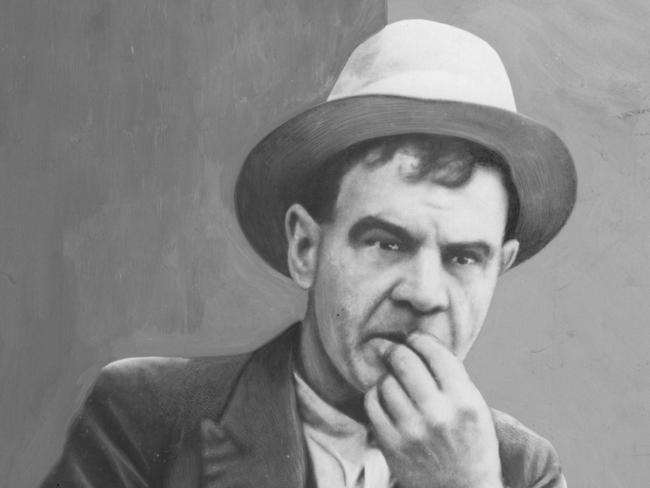
He died in prison but his chilling confession has had people wondering whether he was one of Australia’s worst serial killers.
He was born Albert Andrew Moss in Narromine in 1885 and as a youth he was known for avoiding real work. He seems to have taken to the “wallaby track” early in his life, moving from place to place with a swag, scrounging food or looking for handouts. At 17 he was convicted of theft and that became his main mode of living, thieving from other itinerants. Brought up on a range of charges including burglary, forgery, assault, assault with intent to rape and possession of stolen goods, he grew to hate serving time in prison and, in about 1911, hit on a way to avoid it.
He found that if he acted like he was crazy he would be referred to a doctor, spend a short amount of time in a mental asylum, return to behaving normally, after which he would be deemed cured and then walk away free. He developed many different routines for faking insanity, including tearing at his clothing, dropping to the floor and thrashing about, chewing on soap so that he would froth at the mouth, bashing his head against walls, muttering prayers aloud in court and shouting out profanities.

On one occasion it backfired. In 1926 when up on charges of the attempted rape and assault of a schoolgirl, he ripped at his clothes in court, convincing the judge that he was dangerous and he spent seven years locked in a mental hospital.
Back out on the street the crimes continued and so did his faking insanity to evade the consequences. But in December 1938 his activities took a darker turn. Leather worker William Bartley, originally from Lidcombe, vanished from his camp on the banks of the Macquarie River while he was working in Narromine. Moss had been noticed hanging around Bartley’s camp and was seen riding a bicycle that looked like one belonging to Bartley. Moss claimed it was given to him by a young man after he had won a lottery prize.
A few days later swagman Timothy O’Shea also disappeared. Later Moss was seen riding around in O’Shea’s sulky (a form of horse-drawn cart). Again Moss had an excuse, saying O’Shea wanted him to look after his horse and cart while he went to see friends in Western Australia.
In January 1939 Thomas Robinson disappeared under similar circumstances and Moss was later seen riding around in a cart resembling one Robinson had been driving.
Police began investigating the disappearances, taking Moss in for unlawful possession of stolen goods. As they questioned witnesses and searched for clues the circumstantial evidence began to mount against Moss — pieces of burnt bone, teeth, scraps of bloodied clothing near his campsites, stories about Moss riding around in sulkies and suddenly coming into money.
When they questioned Moss he went into one of his mad routines, hopping like a kangaroo and flapping his arms like a bird. The police ignored it, knowing his past form. Seeing the net was closing in around him, Moss later confessed to the killings, but deliberately spun bizarre stories about disposing of the bodies.
He was tried for the murder of O’Shea and sentenced to death but that sentence commuted to life behind bars. Police investigated his claims of having killed 13 people, but believed it was another attempt to fake insanity. He died in a hospital in Long Bay in 1958.
*****
TRAGIC DEATH OF ARTIST WHO INSPIRED THE GOLDFINCH MOVIE
The city of Delft in South Holland in the Netherlands was going about its business on the morning of October 12, 1654. Amid the hustle and bustle an inspector was making his way to the cellar of a former monastery to check on a gunpowder magazine.
The magazine stored ammunition used by the Dutch army in the event of foreign invasion. It was only six years since the end of the Eighty Years War during which the Dutch had fought for independence from Spain. The inspector, Cornelis Soetens, accompanied by a colleague, went to collect a sample of the gunpowder for testing.
It is not known exactly what happened next but, at about 11.30am, Soeten’s lantern must have set fire to some of the gunpowder and it exploded. Soetens and the man with him were killed instantly as the first explosion set off more blasts. It became known as the “Delft Thunderclap”, the explosions and the resulting fire destroying a large section of the city. Some accounts say over 100 people died.
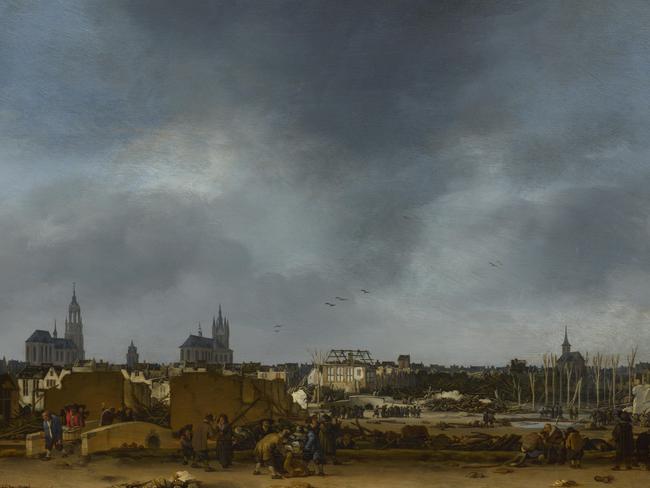
Among the casualties was painter Carel Fabritius, one of several artists who perished in the disaster. His death at age 32 ended a promising career of a promising painter. Fabritius is best known for one work, known as The Goldfinch (or Het Putterje in Dutch), showing a small finch sitting on a bird feeder, its leg chained to a metal hoop attached to the feeder. Although a well-known work, the painting has been made even more famous by Donna Tartt’s 2013 best-selling novel The Goldfinch and the movie adaptation starring Nicole Kidman which opene in cinemas this week. The book and the film have rescued Fabritius from obscurity and granted him recognition by a new generation. It is unknown how many of his artworks perished in the explosion, but only 13 have survived.
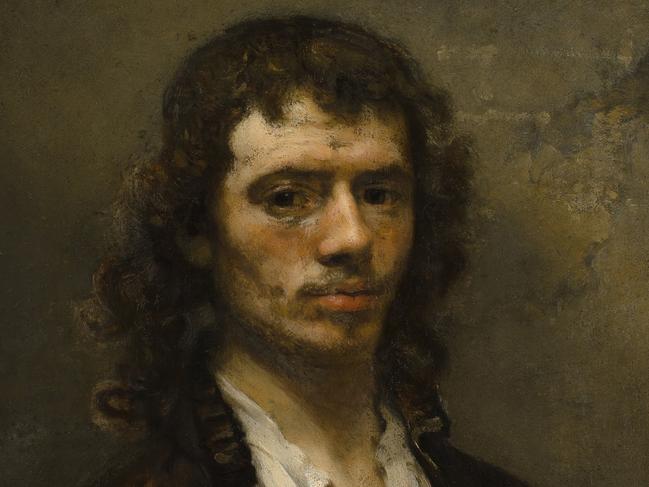
Fabritius was born Carel Pietersz in Middenbeemster in the province of North Holland on February 27, 1622. His father was a schoolmaster who also painted part time. Initially Fabritius took up an apprenticeship as a carpenter, earning himself the nickname “Fabritius”, derived from the Latin word “faber” meaning carpenter. In 1641 he married Aeltge Velthuys, the sister of the parson who lived next door. At some stage early in his life he realised his future was not in making things from wood. After taking lessons in painting from his father he went to Amsterdam to study under master painter and draughtsman Rembrandt van Rijn.
After Aeltge died in childbirth in 1643, Fabritius returned to Middenbeemster. In that same year he painted his first major work The Raising Of Lazarus. This dark, moody image of Jesus standing above Lazarus, the latter figure exuding a glow suggesting he is returning to life, has much in common with the works of Rembrandt.
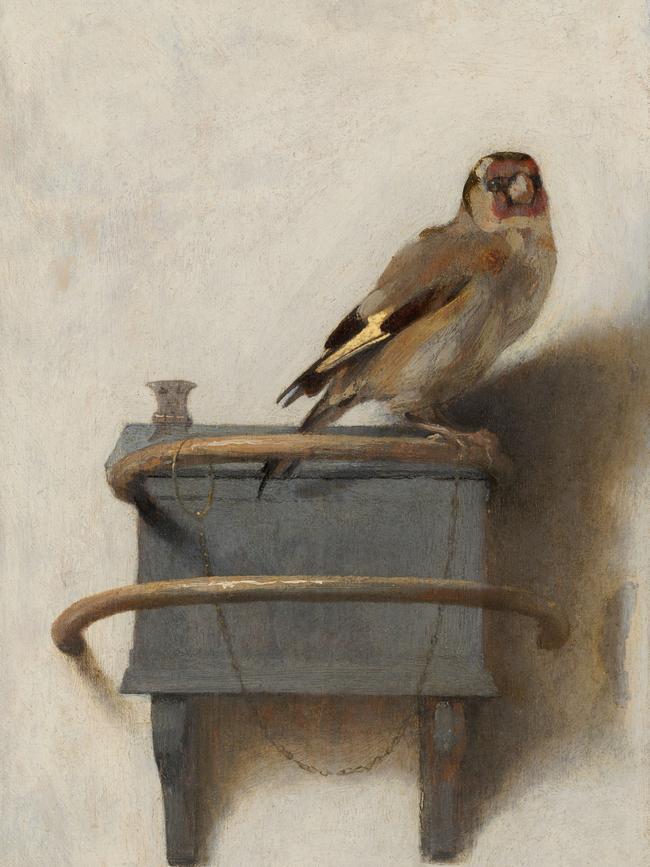
In 1650 Fabritius married widow Agatha van Pruyssen and moved to Delft, where a new school of art was developing, moving away from the work of Rembrandt. His later artworks such as Mercury And Argus show a lighter palette and different colour scheme, particularly in the backgrounds which are all lit rather than bathed in darkness and obscurity. His paintings also show more concern with perspective and more natural light. The similarities with the works of Johannes Vermeer (born in 1632), who also worked in Delft, raise the possibility that the younger painter, Vermeer, may have been influenced by Fabritius. In 1652 Fabritius officially joined the Delft painters guild.

The explosion of 1654 ended Fabritius’s stylistic experiments. Among the last works he painted was The Goldfinch. A small painting, only 33.5cm by 22.8cm, it is painted as a trompe-l’œil, meaning to fool the eye. It would have been hung in a home where a visitor
might at first believe the bird to be real. Goldfinches were popular house pets at the time and could be trained to draw water from a little well in the bird feeder, hence the original Dutch name for the painting, which means “the little well drawer”.
It is not known for whom the painting was originally created but in the early 19th century it was in the collection of Chevalier Joseph-Guillaume-Jean Camberlyn, a military officer and noted art collector. He died in 1861 and the painting was sold in Paris in 1865, passing through several collections until it was acquired by the Mauritshuis in The Hague in 1896.
In Tartt’s book the painting is taken following an explosion in art gallery. While the original artwork has never been stolen, it is believed to have been hanging in Fabritius’s studio when he died in the explosion although Tartt says she was unaware of how he died when she wrote the book.
SEPTEMBER 21, 1849: BIRTH OF MAURICE BARRYMORE
Herbert Blythe was a disappointment to his father William. The elder Blythe was a surveyor for the British East India Company, based in the Punjab, who sent his son to England to get the best education in the hope he would become a barrister. But despite gaining admission to the bar, the law held no interest for young Herbert.
At Harrow and Oxford he had been captain of the football team. He also took up boxing, winning the middleweight boxing championship of England in 1872. It whet his appetite for applause. After falling in with a group of actors he decided there were less taxing ways of getting in front of an audience than being punched and announced to his parents his intention to become an actor.
His father was mortified, so to avoid embarrassing him by having the family name appear on a marquee, Herbert adopted the stage name Maurice Barrymore. He made his professional stage debut in London before moving to the US where he founded a dynasty of great actors, including his three children, Lionel, Ethel and John, and great-granddaughter Drew.

Maurice Barrymore was born Herbert Arthur Chamberlayne Blythe, 170 years ago today on September 21, 1849, at Fort Agra, India. The youngest of seven children, his mother died shortly after he was born. He was sent to England to be raised by an aunt and educated at English schools, as was fitting for a member of the British middle class.
As the youngest in the family Barrymore craved attention, testing the boundaries of acceptable behaviour. His sense of mischief remained with him for most of his life. At school he indulged in pastimes not normally suited to respectable middle-class boys, taking up boxing and mixing with thespians. Yet when he rebelled against his father by taking up acting, he still showed enough concern for his father’s opinion to change his name and spare the family any shame. He chose the surname Barrymore, after William Barrymore, an English actor whose name he had once seen on a poster. That Barrymore had made his debut in London in 1827 but later went to the US where he died in 1847.
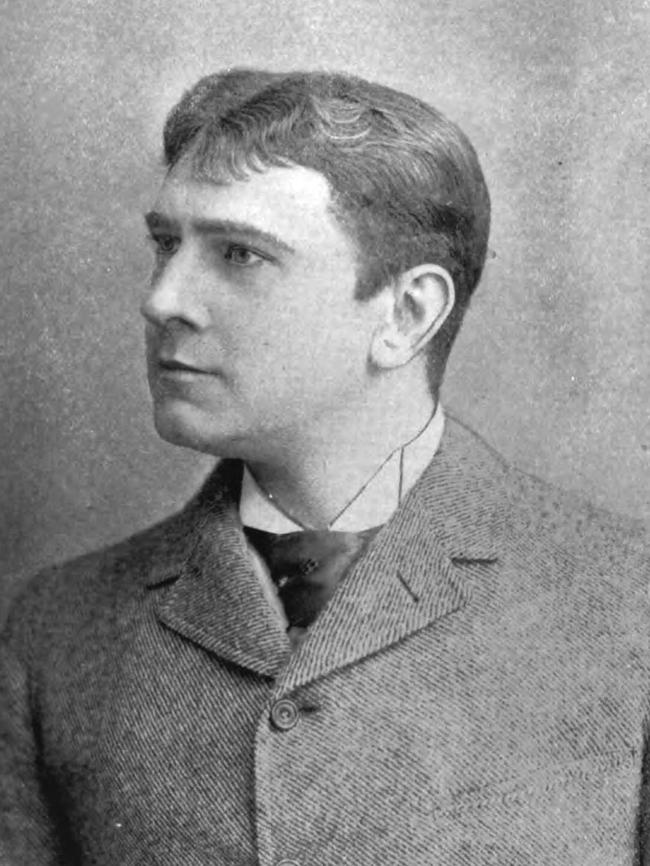
To his friends Maurice Barrymore became known simply as “Barry”. He made his debut in London in 1874, but then followed his namesake and migrated to the US. He joined Augustin Daly’s theatre troupe and made his debut in Under The Gaslight in Boston. He went on to perform in everything from Shakespearean tragedies to light comedies.
The handsome Englishman was also a hit off stage in social circles, regaling them with witty repartee. On one famous occasion, after listening to actor and playwright Steele Mackaye give a recitation from a play Mackaye had just written and starred in, Barrymore yelled out “Bravo! A hundred times bravo! Mackaye, you ought to be an actor!”
Touring with famous Polish actor Helena Modjeska, she once berated him for being a bit lacking while playing opposite her. She told him: “It is ungrateful of you to be so regardless of my interests, when I have made a reputation for you here in America.” To which Barrymore replied: “My dear madam, I may have been indifferent in that scene, but I must beg the privilege of contradicting you when you say you made a reputation for me. I was a
well-known actor here when most people thought that Modjeska was a tooth wash or a headache cure.”

In 1876 Barrymore married Georgiana Drew, the daughter of John Drew, an Irish-born American actor and producer, and his wife the English-born Louisa Drew. But it was a rocky marriage and she threatened to divorce him over his many affairs including one with Modjeska, who was godmother to their daughter Ethel. They had a son Lionel in 1878,
followed by Ethel in 1879, and another son John in 1882.
While touring Texas in 1879 Barrymore and fellow actor were shot in the chest by a drunk gunfighter Jim Currie. Barrymore survived after being operated on, but his colleague died.
Barrymore and Georgiana finally divorced in 1893 and in 1894 Barrymore married Mamie Floyd, described in one newspaper as “an heiress but a member of the profession.” The marriage didn’t last and they were divorced by 1900. By then Barrymore was beginning to suffer the effects of syphilis. During a performance in 1901 he suddenly became unable to remember his lines and started to talk incoherently. He was committed to an asylum in Amityville in New York.
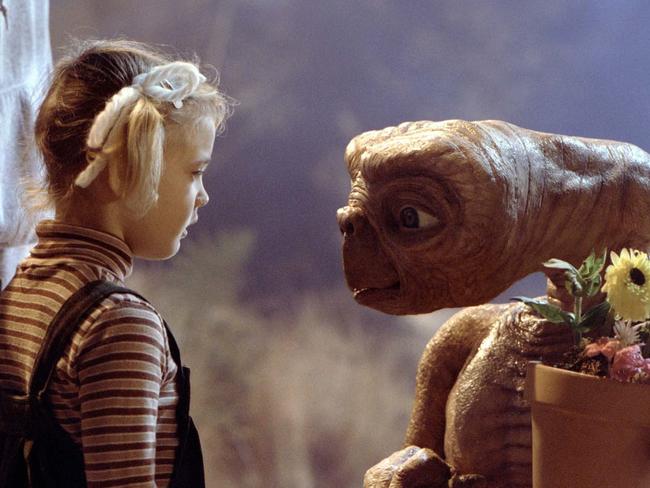
By the time he died on March 25, 1905, all three of his children were making a name for themselves as actors. Lionel had made his professional stage debut at 15 alongside his grandmother Louisa, but was reluctant to make a career of it. He later said he wanted to be an artist or a composer, but found it hard to resist the family tradition. After winning acclaim on stage, he signed with a film company in 1927 appearing in dozens of films, including playing Rasputin in Rasputin And The Empress (co-starring with sister Ethel and brother John) and in It’s A Wonderful Life. He died in 1954.
Ethel wanted to be a concert pianist but made her Broadway debut in 1895. She spent several years in London where, it was rumoured, Winston Churchill proposed to her. She later returned to the US, acting on stage, in film and on television, and dying in 1959.
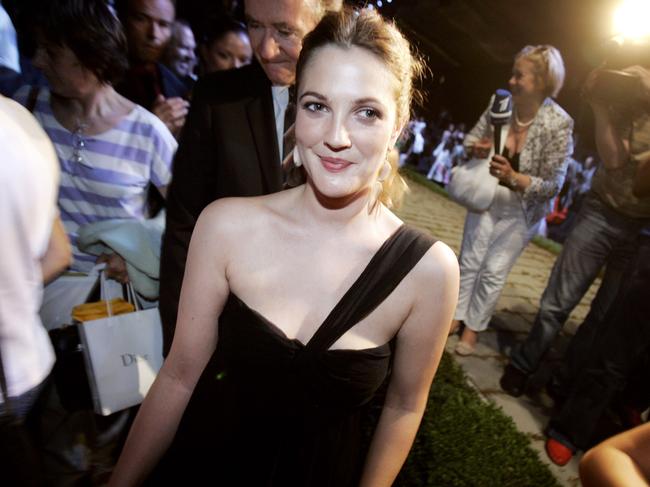
The youngest, John, made his stage debut in 1903 and his film debut in 1913. His most acclaimed role as Hamlet, was in 1922, after which he was in demand for films. He died in 1942 after a life of alcoholism.
In 1932 John had a son, John Drew Barrymore, by his wife, actor Dolores Costello. He made his film debut at 17, under the name John Barrymore Jr, but he never reached the same heights as his forebears. He died in 2004.
Two of John Drew’s children went on to become actors. John Blythe Barrymore III, born in 1954, whose career also included mainly TV and B-grade films. His half-sister Drew Barrymore, born in 1975, came to fame in the film E.T. and survived a troubled childhood to have a successful film career including a string of popular rom-coms.
*****
SEPTEMBER 21, 1949: PEOPLE’S REPUBLIC OF CHINA IS FOUNDED
There was a palpable sense of occasion as delegates gathered for the Chinese People’s Political Consultative Conference in Peking, on September 21, 1949, 70 years ago tomorrow. With the eyes of the world upon them and after decades of internal conflict communist leader Mao Zedong talked about the victory of the Communist Party of China (CPC) forces over those of the nationalist Kuomintang (KMT) under Chiang Kai-shek. He said they had unified the country and established an “entirely new foundation”.
“The Chinese people, comprising one quarter of humanity, have now stood up,” he said, ending the speech by saying: “Hail the victory of the People’s War of Liberation and the people’s revolution! Hail the founding of the People’s Republic of China! Hail the triumph of the Chinese People’s Political Consultative Conference!”

Days later, on October 1, Mao would officially declare the founding of the republic of China. It was the culmination of decades of political struggle and the start of China’s communist era. Although called a republic, Mao and his party established their own virtual monarchy and although things have changed the party still maintains its authoritarian rule.
Just 50 years before the communists came to power, China was still overtly a monarchy under the Qing dynasty. In 1911 a revolution ousted the Qing and ushered in an era of political uncertainty. Military leader Yuan Shikai emerged as leader of a constitutional monarchy, ruling with the support of the KMT in parliament but after the abdication of the emperor, Yuan tried to make himself emperor. Yuan’s death in 1916 saw the nation divided into virtual fiefdoms under various military and political leaders.
In 1923 the KMT, with support from the Soviet Union, established an alternative government in Guangzhou under leader Sun Yat-sen. The KMT entered into an alliance with the CPC, founded in 1921, of which Mao was by then a member, although not yet leader. Sun’s death in 1925 resulted in Chiang becoming leader of the KMT. Chiang was no friend of the communists and started to purge his party of CPC members. Things became bloody in 1927 when Chiang reacted to attempts by the communists to spark a worker and peasant uprising, outlawing the party and slaughtering many communists. Mao and other communists retreated to the mountains and began to wage a guerrilla war on the KMT. The communists built up their forces and gained support from the peasants and workers as Chiang’s policies became more oppressive.

In 1931 he established the Chinese Soviet Republic in Jinagxi province. But in 1934 KMT forces almost annihilated the communists, forcing them to begin their “Long March” from Jiangxi to the northwest province of Shaanxi, fighting all the way. By the time they reached Jiangxi their force of 100,000 was reduced to 8000 by casualties, illness and desertions. They began a drive to recruit more members.
War with the Japanese in Manchuria (following their invasion in 1931) convinced the KMT and the Communists to join forces to defeat their common enemy and put the civil war on hold.
With the 1945 surrender of the Japanese, it looked as if the KMT and Communists might work together for a democratic China. But in 1946 fighting erupted again between nationalists and communists as both scrambled to take areas once controlled by the Japanese and occupied after the war by the Soviets. This time the KMT had the backing of the US who feared the spread of communism across Asia, but the communists gained the initiative in battle. They also gained more support from the Chinese people thanks to the corruption rife within the KMT, its authoritarianism and its dependence on the US, which made it deeply unpopular.
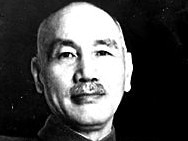
By December 1947 Mao was confident enough of victory to say “The main forces of the People’s Liberation Army have carried the fight into the Kuomintang area. … This is a turning point in history.” As the communist forces continued to grow and gain more territory, troops began to desert the KMT army. By late 1948 the communists controlled a third of China, including many strategically important cities and ports.
In January 1949 Tianjin fell to the communists and days later Chiang resigned as president of China. The Nationalists continued to try to negotiate with the communists as city after city fell to Mao’s armies. With the Nationalist forces all but defeated, Mao was finally able to claim victory in September 1949.
*****
SEPTEMBER 19, 1919; CONSTRUCTION STARTS ON THE GREAT OCEAN ROAD
A century ago today a man sheltering in a dugout in Victoria pressed a button setting off a huge explosion. The war had been over for nearly a year and this was no random act by an anarchist, but a gesture by Victorian premier Harry Lawson to mark the “turning of the first sod” for the construction of the Great Ocean Road.
The explosion dislodged tonnes of rock from a hill near the pretty Victorian seaside town of Lorne, the first step in making the scenic, winding, coastal road, stretching more than 240km from Torquay in the east to Apollo Bay in the west. It would take a team of about 2400 returned servicemen and 600 civilians more than 13 years to build it, but few would argue that the time and money spent to create the road acknowledged as one of the world’s great scenic drives was not worth it.
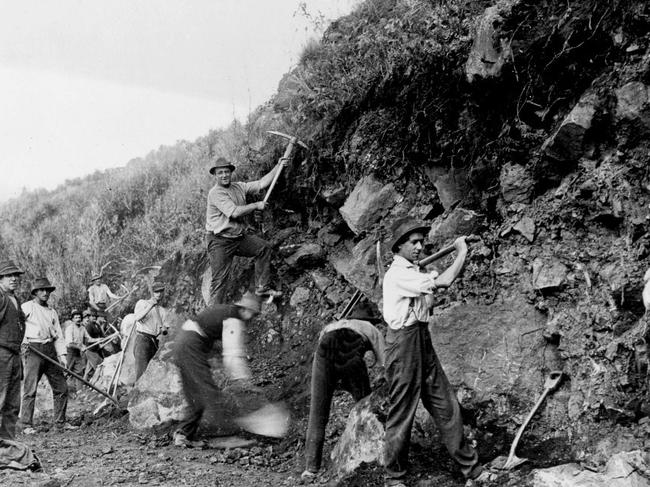
In the 18th century the towns that grew up along that part of Victorian were isolated and accessible only by rugged, unfriendly, overland horse and cart trails or, as was mostly the case, by sea. But part of the shore along which the road would eventually be carved out was also known as the “Shipwreck Coast”.
Ships going to and from the towns had to negotiate often fierce seas and a rugged shore about which Matthew Flinders said he had never seen “a more fearful coastline”.
In the late 19th century people had suggested building a road to link the towns. In 1889 a newspaper report talked about the possibility a building a road to Apollo Bay, saying: “The making of the road to the Bay will cause a large increase in the traffic to that favourite resort, and as the country becomes opened up so will its beauties become known.”

But it was not until near the end of World War I that enough momentum gathered behind the many proposals to begin making it a reality. In 1918 engineer William Calder, chairman of the Country Roads Board (CRB), proposed funding be made available to employ returned servicemen on building what he called the South Coast Road, from Barwon Heads around Cape Otway then on to Warrnambool. The problem was since it was neither a main road nor a development road, it couldn’t be financed by the CRB.
But his idea was enthusiastically taken up by Geelong’s Mayor Howard Hitchcock, who thought it would be a fitting memorial to the soldiers who fought in the Great War. He helped establish the Great Ocean Road trust in May 1918, securing £81,000 in private subscriptions for the construction, also contributing £3000 of his own money. The money spent on building the road would be recouped by charging drivers a toll. The CRB offered to supervise the work and make sure it was up to CRB standards.

Surveying work was done by a team under ex-serviceman Warrant Officer John Hassett, from August to September in 1919. Although some preliminary work had already been done, the official start of construction was on September 19, 1919, when premier Lawson pressed the button to detonate explosives removing the first rock from a cliff near Lorne.
But in January 1920 Hassett reported that the work wasn’t going well. It was decided instead to concentrate on a section from Lorne to Geelong.
Former servicemen, used to carving out trenches while dodging bullets, were only to happy to sign on for this digging work. They earnt 10 shillings and sixpence for an eight-hour day, doing most of the clearing work by hand with picks and shovels, aided by explosives. Workers slept in tents and under blankets both supplied by the government’s Repatriation Department. It was often dangerous work, at least two men were killed when a sand mine collapsed.
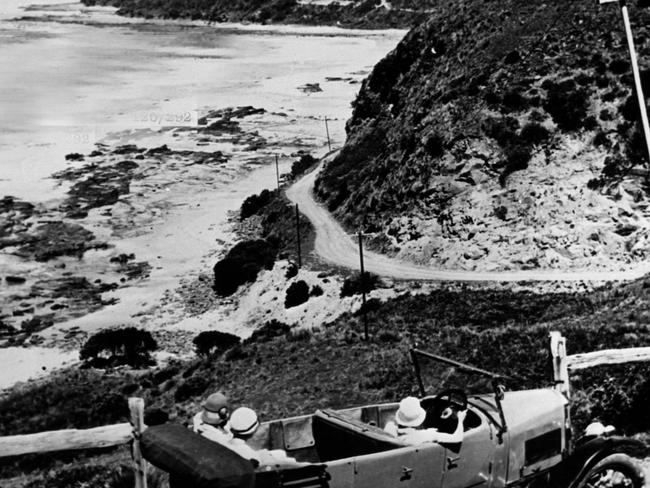
In March 1922 Lord Stradbroke, Governor of Victoria, officially opened the first stretch of the road from Eastern View to Lorne. The road later had to be closed for improvements and in 1923 work began on the next section, this time partly financed by a state government grant of £50,000 made available for building tourism roads.
In 1924 diggers working on the road went on a two-week bender when the ship Casino was forced to jettison some of its cargo of beer and spirits after getting into trouble along the coast. On November 25, 1932, the road was officially opened by Lieutenant Governor Sir William Irvine in a ceremony held near Lorne’s Grand Pacific Hotel.
For information on special centenary events see visitgreatoceanroad.org.au/iam100
*****
SEPTEMBER 18, 1889: BIRTH OF WAR HERO LT GENERAL LESLIE MORSHEAD
It is one of our best known images from Gallipoli, a young officer standing in a trench at Lone Pine, gazing up at dead soldiers along the parapet, his face showing the pain and shock endured by all those who saw their comrades fall in the futile campaign.
The officer was Major Leslie Morshead, a former schoolteacher turned outstanding warrior who would go on to become one of Australia’s best generals, fighting on the Western Front after Gallipoli and becoming a general in World War II.
Born 130 years ago, on September 18, 1889, he fought in many battles involving the Australian Army in both wars, but had skills that translated to peacetime, running a shipping line, a bank and a department store.

He was born Leslie James Morshead in Ballarat, the sixth of seven children of William and Mary Morshead. When William died in 1895 Morshead’s mother Mary kept her children at school and Leslie shone as a student. He also showed leadership qualities as captain of the football and cricket teams at Mount Pleasant State School where he would have also received some military training in the school’s cadet corps. In 1906 he became a junior teacher there.
This set him on a career in education, going on to Melbourne Teachers’ Training College to earn his qualification to teach. He deferred a scholarship to start teaching in schools in country Victoria, later leaving the state system and moving to NSW to teach in Armidale. In 1914 he returned to Victoria to take up a position at the prestigious Melbourne’s Church of England Grammar School, where he also trained the school’s cadets, a role for which he was by then well qualified to undertake.
Morshead had developed an interest in the army and had joined the Australian Army Cadets when it was first formed in 1906, gaining his commission as a lieutenant in 1908 and being promoted to captain in 1913. When war broke out in August 1914 he was quick to join up, appointed a lieutenant in the Australian Imperial Force (AIF).

Posted to the 2nd Battalion, he had earnt a promotion to captain by the time he took part in the Gallipoli landing on April 25, 1915. He was a major by the time of the battle for Lone Pine in August but struck down by illness he was evacuated in September, first to Lemnos and then England. Promoted to Lt Colonel after his recovery he was sent home to Australia to raise his own 33rd Battalion, which he commanded with distinction on the Western Front. He was at the battles of Messines, Passchendaele, Villers-Bretonneux and Amiens, for which he was later awarded the French Legion of Honour. He was also awarded a DSO and was knighted a Companion of the order of St Michael and St George.
With the war over in 1920 his commission in the AIF was ended and he found he couldn’t apply for a position in the regular army because he lacked a qualification from Duntroon. He took up farming on a soldier-settlement scheme plot of land, but found he wasn’t well suited to it. He returned to teaching and in 1921 married Myrtle Woodside.

He then found work in shipping, moving up to become manager of the Orient Steam Navigation company in Australia, while still maintaining involvement in the Australian Militia.
When war came again in 1939 he again joined the AIF, as a colonel, but was soon promoted to brigadier. After spending several months in England, where he was awarded a CBE in 1941, he was sent to the Middle East. He helped organise the defence of Tobruk during the long siege of the town. Germany’s American-born British radio propagandist William “Lord Haw Haw” Joyce dubbed Morshead “Ali Baba and his 20,000 thieves”.
Evacuated from Tobruk in October 1941 in 1942 he was appointed KBE, promoted to Lt General and then returned to take over from Thomas Blamey in the Middle East, playing a part in the battle of El Alamein.
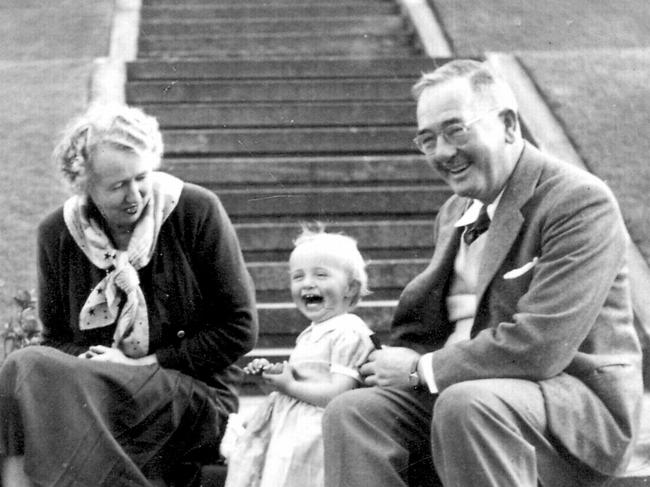
After playing their part in the defeat of the Axis armies in North Africa Morshead and his troops returned to Australia in 1943, later taking part in battles to drive the Japanese out of New Guinea and Borneo. In 1946 he returned to his job at Orient and later joined the boards of several companies, including David Jones. In 1954 after retiring from Orient he was elected president of the Bank of NSW.
When he died in September 1959 thousands lined the streets to pay tribute. At his funeral the Rev C.A. Osborne summed him up by saying: “He was a man who, above all, had courage, determination, thoroughness, vision, sympathy and a simple understanding of all his men.”
Originally published as Today in history: Hungry dogs put Russian scientist Ivan Pavlov on track for Nobel Prize



